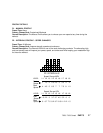
EXERCISE GUIDELINES
Always consult your physician before beginning an exercise program.
How Often?
The American Heart Association recommends that you exercise at least 3 to 4 days per week to maintain cardio-
vascular fitness. If you have other goals such as weight or fat loss, you will achieve your goal faster with more
frequent exercise. Whether it’s 3 days or 6 days, remember that your ultimate goal should be to make exercise a
lifetime habit.
Many people are successful staying with a fitness program if they set aside a specific time of day to exercise. It
doesn’t matter whether it’s in the morning before your shower, during lunch hour or while watching the evening
news. What’s more important is that it’s a time that allows you to keep a schedule, and a time when you won’t be
interrupted. If you are to be successful with your fitness program, you have to make it a priority in your life. So
decide on a time, pull out your day planner and pencil in your exercise times for the next month!
How Long?
For aerobic exercise benefits, it’s recommended that you exercise from between 24 and 32 minutes per session.
But start slowly and gradually increase your exercise times. If you’ve been sedentary during the past year, it may
be a good idea to keep your exercise times to as little as five minutes initially. Your body will need time to adjust
to the new activity. If your goal is weight loss, a longer exercise session at lower intensities has been found to be
most effective. A workout time of 48 minutes or more is recommended for best weight loss results.
How Hard?
How hard you workout is also determined by your goals. If you use your Vision Fitness Treadmill to prepare for
racing, you will probably work out at a higher intensity than if your goal is general fitness. Regardless of your long
term goals, always begin an exercise program at low intensity. Aerobic exercise does not have to be painful to
be beneficial!There are two ways to measure your exercise intensity. The first is by monitoring your heart rate,
and the second is by evaluating your perceived exertion level (this is simpler than it sounds!).
To monitor your heart rate you can use a pulse monitor or take your pulse with your fingers. Pulse monitors are
a convenient tool for monitoring heart rate, but make sure you use an accurate one. An inaccurate pulse monitor
is of little value. You can measure your pulse with your fingers by placing your first two fingers lightly over the
blood vessel (carotid artery) on your neck located next to your Adam’s apple. Count your pulse for ten seconds
and multiply by six. This figure is your heart rate in beats per minute. Compare this number to the Target Heart
Rate Zone for your age group.
33
PART 5
Developing a Fitness Program


















